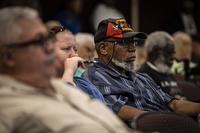Dear Sgt. Shaft,
I was separated from the USN back in 1987 – I don’t have my DD214 at hand so I can’t give exact dates just now – with a General Discharge under Honorable Conditions because I was unable to get my weight low enough for their requirements. There were no conduct issues whatsoever during my tour nor have I had so much as a speeding ticket since my separation. Indeed, I graduated all my military schools at the top of my classes. I enlisted to serve my country and made every effort to do so but my weight was something I just could not control. I participated in the USN exercise program every day and was on a diet they required but my weight would not cooperate through no fault of my own so I was finally separated. In addition I took every PRT along the way although I was required to sign a waiver so the test did not “count” however I got a SAT on every one of them. I should also perhaps mention that I was 34 at the time having served around 2 years.
As the years go by I find that I am more and more disappointed with the smudge against my name that the General/Honorable discharge implies and would like to petition having it upgraded to a full Honorable. However, I do not know how to even begin such a process. Someone suggested I contact you as he feels sure you would know exactly whom I should contact and what information I would need to present.
Ken B
Florida
Dear Ken,
The experts at the Military officers Association of America (MOAA) tell me that in order to appeal the nature of your discharge, you must file an appeal with the Board for Correction of Naval Records. The application procedures are explained in this paper. When filing an application, keep your application short and to the point. Stick with the facts and how your situation complies with laws, regulations and/or policies. Also see this page for more details.
Shaft Notes
• By now, nearly everyone knows the Department of Veterans Affairs is in dire need of reform. Oversight by the House Committee on Veterans’ Affairs and whistleblower revelations have exposed widespread corruption, systemic delays in access to medical care and failures in accountability across the board at our nation’s second largest federal agency.
As more than 110 VA medical facilities maintained secret lists to hide long waits for medical care, thousands of veterans throughout the country were neglected. Some for years, some in pain, some while chronic or fatal conditions worsened until little hope remained. At least 24 veterans have died because VA didn’t provide them with the health care our nation had promised. Except for a pair of employees in Columbia, S.C., and Augusta, Ga., who received a temporary written warning and a verbal counseling, respectively, no VA administrators who presided over the deaths have been subject to any formal disciplinary actions outside of paid leave.
So how did things get to this point? The unfortunate truth is that top leaders simply ignored or denied the department’s problems at every turn.
For more than a year, I pleaded with former VA Secretary Eric Shinseki to do something to address the culture of complacency that was taking hold within the department. I wrote him about a host of serious and specific patient safety issues at VA hospitals. I personally told him his own employees were lying to him about the department’s performance. I asked him why in the wake of dozens of preventable deaths at VA medical centers around the country no VA employees had been held accountable.
In response, Shinseki downplayed my concerns and chose to believe the VA employees whose lies allowed the VA scandal to fester. Now Shinseki has been forced out of his position, while those who created the department’s delays in care crisis are still on the payroll.
Because of Shinseki’s failure to address my concerns, I wrote to President Obama in May of 2013 to request his assistance in addressing a number of patient-care issues at VA medical centers around the country. But the president never bothered to reply. Instead I received a boilerplate letter from Shinseki that said in part, “VA embraces a patient safety culture that allows staff to feel safe to report patient safety risks.”
If only that were true. As dozens of VA whistleblowers have come forward over the past few months, we’ve learned that in instance after instance at one VA facility after another, brave employees who have spoken out about mismanagement and negligence that harms veterans have been harassed, punished and in some cases fired.
It's impossible to solve problems by whitewashing them or denying they exist. This is the chief lesson of the VA scandal. If incoming VA Secretary Bob McDonald is to have any luck turning the department around, he must learn it well.
As part of a bipartisan VA reform package that recently passed the House and Senate and awaits the president’s signature, Congress has given McDonald a number of tools to immediately address some of the department’s most pressing problems. The legislation includes $10 billion in emergency funding to offer veterans who can’t get VA medical care within 30 days the option to receive non-VA treatment and provides $5 billion to increase the department’s internal medical care capacity. Perhaps most importantly, the legislation grants McDonald complete authority to fire corrupt or incompetent senior VA executives for cause – power he’ll need to use liberally to replace the department’s culture of complacency with a climate of accountability.
House oversight was crucial in bringing VA’s problems to light, and it will not stop once the president signs the Veterans Access, Choice and Accountability Act of 2014 into law.
• Send letters to Sgt. Shaft, c/o John Fales, P.O. Box 65900, Washington, D.C. 20035-5900; fax 301/622-3330, call 202/257-5446 or email sgtshaft@bavf.org.










